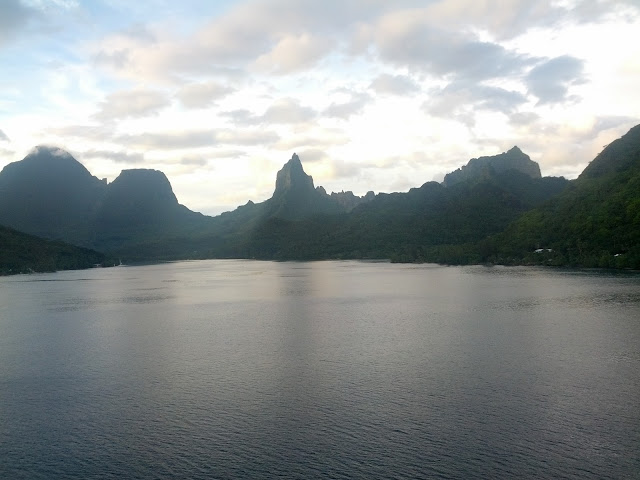First up, the pearl of the Pacific--Tahiti!
Captain Van Eerten juggled our schedule around so that we went to Tahiti before Mo'orea. It was an absolute necessity because the ship had to take on more fuel and supplies. I suppose this was because there was a typhoon swirling over Fiji and we might have had to skip Mo'orea and make a run for San Diego. But the storm only swatted us with its outer arms.
Tahiti is the largest island in the French Polynesian chain with the highest peak. This gorgeous place is home to most of the inhabitants, almost 200,000 of them. The interior of the island still pretty inaccessible. People live in the capital city of Pape'ete and along the single road hugging the reef-sheltered coasts.
We took a bus tour along that route and stopped at a beautiful botanical garden. It was drizzling for most of our jaunt through the rain forest, which made it difficult for my DH. He was wearing my portable oxygen concentrator on his back. It was both heavy and hot, but he didn't complain.
God bless the man!
The flowers were gorgeous, though I can't tell you their names, and small crabs scuttled across the path as we pushed through the greenery. It felt and smelled very primeval.
The path was nicely graveled, but as humid and hot as it was, it felt like we were going uphill both ways!
Forget the umbrella. Not a single square inch of me is dry.
But finding this secluded waterfall was well worth the slog into the rainforest to get there.
We visited the Museum of Tahiti and learned about the volcanic birth of the islands and how their reefs were formed. Polynesian culture is fascinating and I'm still in awe of the courage it took to head out in double hull canoes with only the navigational skill of their Wayfinder to guide them. These ancient wayfarers used the stars, weather patterns, sea birds, and changes in water color and direction to point them toward land.
Much was said about the time French Impressionist Paul Gaugin spent in Tahiti. None of his canvases remain on the island, but I can certainly see why he found the place inspiring.
A mere 12 mile ferry ride away lies the enchanting island of Mo'orea. The movie The Bounty (with Mel Gibson & Anthony Hopkins) was set on these shores, When I stepped out onto our veranda shortly after the Westerdam dropped anchor, the sheer beauty of the place made the back of my throat ache. I was so grateful to be there, to see that grandeur, to breathe in that moist green air. It made me weep. Even in drizzly weather, it is truly the most beautiful island I've ever seen.
We took a "round the island" tour with a strange little bus driver named Albert. He told us he had 3 wives (all at the same time!), 12 children and more grandkids than he could remember. The highlight of the trip was this lookout point about 3000 ft up the mountains looking down on the twin bays. You can barely make out the Westerdam at anchor in the mist.(It's that rectangular object in the water.)
In the early morning, the island is awash in shades of slate and gray.
As in the southern part of the US, pineapples mean welcome!
The vanilla flower, sweet, simple and difficult to pollinate.
The influence of French settlers is easy to see.
A giant in the mist...
At the end of the 30 days, we weren't tired of the ship, but we were missing our family, our pets and our own bed! It was a wonderful experience and we feel so blessed to have been able to celebrate our 40th anniversary in this way.
But, we're not the sort to rest on our travel laurels. We've already booked cruises to the western Caribbean in January 2017 and then we're off to Alaska in September of the same year. Then in 2018, we'll try Cunard for the first time and take the 21 day sale out of New York to Norway and back on the Queen Mary 2!
Wishing you safe journeys and a snug harbor, my friends...



















































